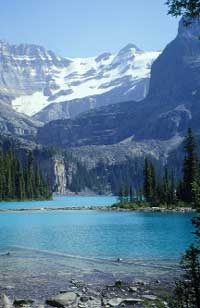 Alberta's WaterIntroductionPublications Climate Change Industrial Impacts Agricultural Impacts Urban Impacts Biodiversity Loss Definitions Links Site Map |
 |
|
 |
 |
| Moab Lake Fire 2000 Jasper National Park (Parks Canada) |
Study Lake: Lake O'Hara, Yoho National Park |
Forest Fire and Hg
While completing initial sampling of the study lakes, 72% of the catchment of Moab Lake burned in a forest fire. This provided an opportunity to quantify some of the effects of fire on water chemistry and Hg dynamics in aquatic systems. Moab Lake and 4 creeks (2 creeks in burned catchments and 2 in unburned catchments) were sampled during the ice-free period for 2 years. The results should reveal important information about the impact of forest fires on mercury cycles.Preliminary results reveal elevated concentrations of mercury in water and some organisms post-fire.
Acknowlegements
Invaluable field and lab assistance was provided by Brian Parker, Michelle Bowman, Cathy Lemmon, Kathy Vladicka, Laurie Cheperdak, Mark Van Dorn, and Parks Canada wardens. Many thanks to Dr. David Kelly, Jane Kirk, Megan Pouchniak, and Susitha Wanigaratne of the University of Alberta Low-Level Mercury Analytical Laboratory. This research was funded by the National Science and Engineering Research Council (NSERC), Alberta Science and Research Authority (ASRA), Circumpolar/Boreal Alberta Research (C/BAR), Challenge Grants in Biodiversity, Parks Canada, and Science Horizons.



 Mercury deposition and accumulation in
Mercury deposition and accumulation in